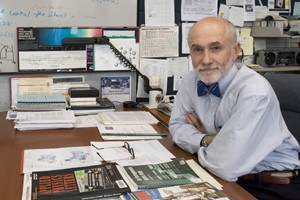
Salmon Garnish Points the Way to Green Electronics
Professor Andrew Steckl, a leading expert in light-emitting diodes, is intensifying the properties of LEDs by introducing biological materials, specifically salmon DNA.
Electrons move constantly think of tiny particles with a negative charge and attention deficit disorder. It is through the movement of these electrons that electric current flows and light is created.
Steckl is an Ohio Eminent Scholar in UCs Department of Electrical and Computer Engineering. He believed that if the electrons mobility could be manipulated, then new properties could be revealed.
In considering materials to introduce to affect the movement of the electrons, Steckl evaluated the source of materials with an eye to supply, especially materials that do not harm the environment.
Biological materials have many technologically important qualities electronic, optical, structural, magnetic, says Steckl. But certain materials are hard for us to duplicate, such as DNA and proteins. He also wanted a source that was widely available, would not have to be mined, and was not subject to any organization or countrys monopoly. His answer?
Salmon sperm.

Applied Physics Letter cover
Salmon sperm is considered a waste product of the fishing industry. Its thrown away by the ton, says Steckl with a smile. Its natural, renewable and perfectly biodegradable. While Steckl is currently using DNA from salmon, he thinks that other animal or plant sources might be equally useful. And he points out that for the United States, the green device approach takes advantage of something in which we continue to be a world leader agriculture.
Steckl is pursuing this research in collaboration with the Air Force Research Laboratory. The research was featured recently in such premier scientific publications as the inaugural issue of naturephotonics and on the cover of Applied Physics Letters.
The Air Force had already been working with DNA for other applications when they came to us and said, We know that you know how to make devices, quotes Steckl. They also knew that they had a good source of salmon DNA. It was a match made in heaven.

Diagram detail from APL cover
So began Steckls work with BioLEDs, devices that incorporate DNA thin films as electron blocking layers. Most of the devices existing today are based on inorganic materials, such as silicon. In the last decade, researchers have been exploring using naturally occurring materials in devices like diodes and transistors.
The driving force, of course, is cost: cost to the producer, cost to the consumer and cost to the environment Steckl points out, but performance has to follow.
And what a performance lights, camera, action!
DNA has certain optical properties that make it unique, Steckl says. It allows improvements in one to two orders of magnitude in terms of efficiency, light, brightness because we can trap electrons longer.
When electrons collide with oppositely charged particles, they produce very tiny packets of light called photons.
Some of the electrons rushing by have a chance to say hello, and get that photon out before they pass out, Steckl explains. The more electrons we can keep around, the more photons we can generate. Thats where the DNA comes in, thanks to a bunch of salmon.

BioLEDs make colors brighter.
DNA serves as a barrier that affects the motion of the electrons, says Steckl. It allows Steckl and his fellow researcher, the Air Forces Dr. James Grote, to control the brightness of the light that comes out.
The story continues, says Steckl, again smiling. Im receiving salmon sperm from researchers around the world wanting to see if their sperm is good enough. The next step is to now replace some other materials that go into an LED with biomaterials. The long-term goal is be able to make green devices that use only natural, renewable and biodegradable materials.
This research was funded by the United States Air Force.
Here we have the yin of biological materials in photonic devices. See Steckls yang research placing electronics in biological materials: UC Engineering Research Widens Possibilities for Electronic Devices: NSF-funded engineering research on microfluidics at the University of Cincinnati widens the possibilities on the horizon for electronic devices.
Related Stories
UC’s Ground Floor Makerspace births combat robots
April 17, 2024
In the heart of UC's 1819 Innovation Hub lies the Ground Floor Makerspace, an advanced and active hub of ingenuity where students, faculty and the community converge to bring their ideas to life. This includes being the birthplace of robots much like miniature race cars, combating fender to fender in an enclosed boxing ring. Combat robots like UC's Maximizer will again be fighting for first place in the National Havoc Robot League (NHRL) competition, slated for April 20.
UC researchers develop new CPAP device
April 17, 2024
Researchers at the University of Cincinnati are developing a VortexPAP machine that takes advantage of vortex airflow technology. A preliminary clinical study with current CPAP users demonstrated that the VortexPAP can deliver the pressure levels that are used in the subjects’ CPAP therapy, but the mask is more comfortable to wear. It has a minimalistic design that is less intrusive and barely touches the patient’s face.
UC architectural engineering alumna inspires high school students
April 16, 2024
University of Cincinnati alumna Emma Wilhelmus fell in love with engineering when she was in ninth grade. After taking drafting, architecture and engineering courses in high school, she set out to major in architectural engineering in college. Now, she is an engineering teacher at a local high school and hopes to inspire students.
